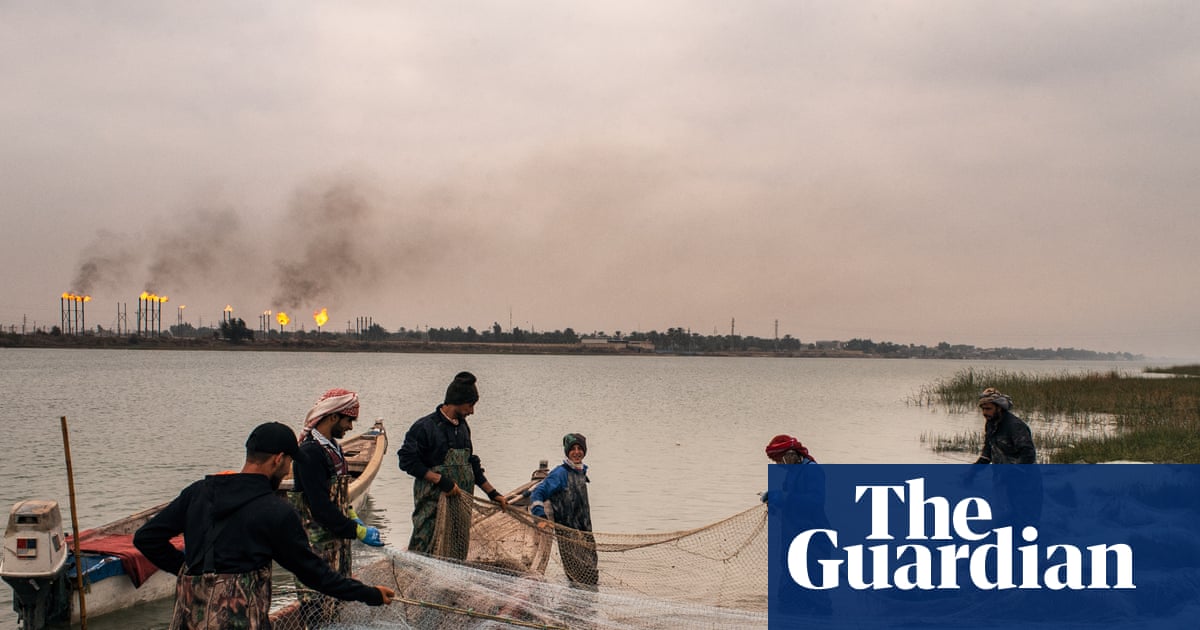‘It’s destruction disguised as progress’: how the oil industry is sucking Iraq’s ancient wetlands dryHawizeh’s wetlands once had abund...
Published on by Water Network Research, Official research team of The Water Network

Hawizeh’s wetlands once had abundant fishing and wildlife. In a land threatened by drought and desertification, oil drilling is draining the last of the water
At dawn, a veil of mist clings to the canals of Hawizeh, where sky and water seem to blur into a mirror. In the stern of a narrow wooden boat, 23-year-old Mustafa Hashim scans the marshes’ shallows, cutting the motor and switching to a traditional pole to avoid snagging on invasive roots or thickening mud.
It takes him about half an hour to push through the shrinking marshes to reach Um al-Nea’aj, once a vibrant lake teeming with boats and birdsong. Now, the water is about half a metre deep.
“Two years ago, there were families and fishermen everywhere,” Mustafa says, leaning out of the boat. “You could hear laughter, the splash of fish. Today, there’s nothing.”
Mustafa Hashim, 23, steers his boat to Lake Um al-Nea’aj. With the changing climate, drought and water extraction, navigation is becoming increasingly difficult. Photograph: Daniela Sala
On the horizon, flames from the Halfaya oilfield flicker.
Iraq’s southern wetlands – known collectively as the Mesopotamian marshes – are among the world’s most endangered ecosystems. Their expanse is believed by some to have contained the biblical Garden of Eden. Recognised as a Unesco world heritage site in 2016 and protected since 2007 as a wetland of international importance under the Ramsar Convention, the marshes once stretched nearly 120 miles (200km) from Nasiriya to Basra, forming a rich and vast aquatic world.
But beneath the surface lies another kind of wealth: oil. Three strategic oil concessions overlap with the protected area: Halfaya, Huwaiza, and Majnoon. The latter, Majnoon, takes its name from the Arabic word for “crazy”: it is considered one of the world’s “super-giant” oilfields, with estimated reserves of up to 38bn barrels (5.2bn tonnes).
But the processes used to extract that oil have a voracious appetite for water. In a land already threatened by drought and desertification, the wetlands are being sucked dry.
Mustafa’s grandfather, Kasid Wanis, 87, once took his boat from Hawizeh to Basra (about 70 miles) using nothing but a pole and his memory of the route. “We didn’t know what cars were. We didn’t need them. We were a people of water,” he says.
His 41-year-old son Hashim, Mustafa’s father, grew up fishing these waters. But four years ago, he packed his nets away. “There’s not enough water to live,” he says quietly.
Crude oil is Iraq’s economic lifeline, accounting for more than 95% of its total exports and 69% of GDP. The country is the world’s sixth-largest crude producer, and the fate of the Hawizeh marshes is tightly bound to that of the oil industry. Since Russia’s invasion of Ukraine in 2022, Europe has sought alternatives to Moscow’s crude, with Iraq becoming a key source.
The connection between oil extraction and water scarcity is direct and devastating. The Halfaya oilfield – in which the French energy company TotalEnergies also holds a stake – is operated by a consortium led by PetroChina.
Spanning an area three times the size of Paris, it includes 300 wells, three oil-processing plants, a water-treatment facility, and its own airport to transport foreign workers between the site and international airports. It is state-owned PetroChina’s largest overseas project.
Fishermen from Qarmat Ali with the Nahr Bin Umar oilfield across the Shatt al-Arab River. They complain that due to pollution and the river’s increased salinity, they often pull in dead fish. Photograph: Daniela Sala
About a decade ago, shortly after PetroChina began operations in the region, six water-pumping stations were built along the Tigris River – the lifeline that feeds the marshes.
Every day, they extract about 60,000 cubic metres of water, roughly the daily consumption of a mid-sized city. That water is diverted to the oilfields, where it is injected into wells to boost crude extraction – a standard practice across the region.
The pumping stations are drawing from already diminished reserves. Dams built upstream in Turkey and the Kurdish region of Iraq have reduced water flow into southern Iraq by more than 50% since the 1970s, while Iranian dams on the Karkheh River – which feeds the Hawizeh marshes – have also reduced the region’s water supply. Now, feeding this industrial oil complex is costing residents their environment and their way of life, they say.
These days, Hashim is less worried about dwindling fish stocks than about the military checkpoints. The canals that once led deep into the wetlands are cut off and patrolled. Armed guards control access, requiring local fishers and buffalo herders to hand over their ID cards to enter.
Attached link
https://www.theguardian.com/environment/2025/aug/13/iraq-marshes-hawizeh-oil-industry-drought-desrtification-water-dry-aoeTaxonomy
- Wetlands
- Wetlands